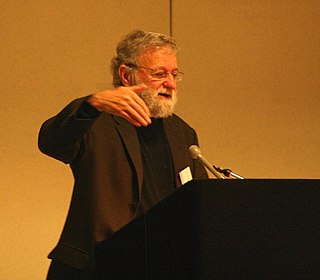Related Research Articles

Psychology is the study of mind and behavior in humans and non-humans. Psychology includes the study of conscious and unconscious phenomena, including feelings and thoughts. It is an academic discipline of immense scope, crossing the boundaries between the natural and social sciences. Psychologists seek an understanding of the emergent properties of brains, linking the discipline to neuroscience. As social scientists, psychologists aim to understand the behavior of individuals and groups.
Neuro-linguistic programming (NLP) is a pseudoscientific approach to communication, personal development and psychotherapy, that first appeared in Richard Bandler and John Grinder's 1975 book The Structure of Magic I. NLP asserts that there is a connection between neurological processes (neuro-), language (linguistic) and acquired behavioral patterns (programming), and that these can be changed to achieve specific goals in life. According to Bandler and Grinder, NLP can treat problems such as phobias, depression, tic disorders, psychosomatic illnesses, near-sightedness, allergy, the common cold, and learning disorders, often in a single session. They also claim that NLP can "model" the skills of exceptional people, allowing anyone to acquire them.
Popular psychology refers to the concepts and theories about human mental life and behavior that are supposedly based on psychology and are considered credible and accepted by the wider populace. The concept is cognate with the human potential movement of the 1950s and 1960s.

Donald Arthur Norman is an American researcher, professor, and author. Norman is the director of The Design Lab at University of California, San Diego. He is best known for his books on design, especially The Design of Everyday Things. He is widely regarded for his expertise in the fields of design, usability engineering, and cognitive science, and has shaped the development of the field of cognitive systems engineering. He is a co-founder of the Nielsen Norman Group, along with Jakob Nielsen. He is also an IDEO fellow and a member of the Board of Trustees of IIT Institute of Design in Chicago. He also holds the title of Professor Emeritus of Cognitive Science at the University of California, San Diego. Norman is an active Distinguished Visiting Professor at the Korea Advanced Institute of Science and Technology (KAIST), where he spends two months a year teaching.

In psychology, cognitivism is a theoretical framework for understanding the mind that gained credence in the 1950s. The movement was a response to behaviorism, which cognitivists said neglected to explain cognition. Cognitive psychology derived its name from the Latin cognoscere, referring to knowing and information, thus cognitive psychology is an information-processing psychology derived in part from earlier traditions of the investigation of thought and problem solving.

Applied psychology is the use of psychological methods and findings of scientific psychology to solve practical problems of human and animal behavior and experience. Educational and organizational psychology, business management, law, health, product design, ergonomics, behavioural psychology, psychology of motivation, psychoanalysis, neuropsychology, psychiatry and mental health are just a few of the areas that have been influenced by the application of psychological principles and scientific findings. Some of the areas of applied psychology include counseling psychology, industrial and organizational psychology, engineering psychology, occupational health psychology, legal psychology, school psychology, sports psychology, community psychology, neuropsychology, medical psychology and clinical psychology, evolutionary psychology, human factors, forensic psychology and traffic psychology. In addition, a number of specialized areas in the general area of psychology have applied branches. However, the lines between sub-branch specializations and major applied psychology categories are often mixed or in some cases blurred. For example, a human factors psychologist might use a cognitive psychology theory. This could be described as human factor psychology or as applied cognitive psychology. When applied psychology is used in the treatment of behavioral disorders there are many experimental approaches to try and treat an individual. This type of psychology can be found in many of the subbranches in other fields of psychology.
Interaction design, often abbreviated as IxD, is "the practice of designing interactive digital products, environments, systems, and services." While interaction design has an interest in form, its main area of focus rests on behavior. Rather than analyzing how things are, interaction design synthesizes and imagines things as they could be. This element of interaction design is what characterizes IxD as a design field, as opposed to a science or engineering field.

Behaviorism is a systematic approach to understanding the behavior of humans and other animals. It assumes that behavior is either a reflex evoked by the pairing of certain antecedent stimuli in the environment, or a consequence of that individual's history, including especially reinforcement and punishment contingencies, together with the individual's current motivational state and controlling stimuli. Although behaviorists generally accept the important role of heredity in determining behavior, they focus primarily on environmental events.

Acceptance in human psychology is a person's assent to the reality of a situation, recognizing a process or condition that is a fait accompli without attempting to change it or protest it. The concept is close in meaning to acquiescence, derived from the Latin acquiēscere.
Walter Mischel was an Austrian-born American psychologist specializing in personality theory and social psychology. He was the Robert Johnston Niven Professor of Humane Letters in the Department of Psychology at Columbia University. A Review of General Psychology survey, published in 2002, ranked Mischel as the 25th most cited psychologist of the 20th century.

Bad Astronomy: Misconceptions and Misuses Revealed, from Astrology to the Moon Landing "Hoax" is a non-fiction book by the American astronomer Phil Plait, also known as "the Bad Astronomer". The book was published in 2002 and deals with various misunderstandings about space and astronomy, such as sounds being audible in space.
Robyn Mason Dawes was an American psychologist who specialized in the field of human judgment. His research interests included human irrationality, human cooperation, intuitive expertise, and the United States AIDS policy. He applied linear models to human decision making, including models with equal weights, a method known as unit-weighted regression. He co-wrote an early textbook on mathematical psychology.

"Backwards: The Riddle Of Dyslexia" is a 1984 episode of the American television anthology series ABC Afterschool Special, about dyslexia. It shows how dyslexia is detected and treated. The episode stars 13-year-old River Phoenix in "one of his first major roles" as Brian Ellsworth. Joaquin Phoenix also stars as his younger brother Robby. According to allmovie, Brian Ellsworth is a junior high student "who has a habit of writing his words – and the letters – backwards. Brian's friends think he's kidding, his teachers think he's lazy, and his parents think he's slow. In truth, Brian has dyslexia and suffers from societal misconceptions and Ableist idiocy."

The 10% of the brain myth states that humans generally use only one-tenth of their brains. It has been misattributed to many famous scientists and historical figures, notably Albert Einstein. By extrapolation, it is suggested that a person may 'harness' or 'unlock' this unused potential and increase their intelligence.

Human–computer interaction (HCI) is research in the design and the use of computer technology, which focuses on the interfaces between people (users) and computers. HCI researchers observe the ways humans interact with computers and design technologies that allow humans to interact with computers in novel ways. A device that allows interaction between human being and a computer is known as a "Human-computer Interface (HCI)".

Behavioural design is a sub-category of design, which is concerned with how design can shape, or be used to influence human behaviour. All approaches of design for behaviour change acknowledge that artifacts have an important influence on human behaviour and/or behavioural decisions. They strongly draw on theories of behavioural change, including the division into personal, behavioural, and environmental characteristics as drivers for behaviour change. Areas in which design for behaviour change has been most commonly applied include health and wellbeing, sustainability, safety and social context, as well as crime prevention.
Scott O. Lilienfeld was a professor of psychology at Emory University and advocate for evidence-based treatments and methods within the field. He is known for his books 50 Great Myths of Popular Psychology, Brainwashed, and others that explore and sometimes debunk psychological claims that appear in the popular press. Along with having his work featured in major U.S. newspapers and journals such as The New York Times, The New Yorker, and Scientific American, Lilienfeld made television appearances on 20/20, CNN and the CBS Evening News.
in psychology the Ovsiankina effect describes the innate human urge to finish tasks we've initiated. This tendency to resume an interrupted action is especially prevalent when the action hasn't yet been achieved. The effect is named after Maria Ovsiankina, who conducted research on this behavior.

Jean Mercer is an American developmental psychologist and professor emerita of psychology at Stockton University. Founder of the advocacy group Advocates for Children in Therapy, she is known as an advocate for adopted children and those who come from the foster care system, and as an outspoken critic of attachment therapy.
David Kyle Johnson is a Professor of Philosophy at King's College in Wilkes-Barre, Pennsylvania. He specializes in logic, metaphysics, free will, and philosophy of religion.
References
- 1 2 Wiley. "50 Great Myths of Popular Psychology: Shattering Widespread Misconceptions about Human Behavior". September 2009. http://www.wiley.com/WileyCDA/WileyTitle/productCd-EHEP002362.html
- ↑ Korn, J.H. (2010). "Myth busters". Psyccritiques, 55(3), doi : 10.1037/a0018442
- ↑ "50 Great Myths of Popular Psychology: Shattering Widespread Misconceptions about Human Behavior".
- ↑ Wiley,"50 Great Myths of Popular Psychology: Shattering Widespread Misconceptions about Human Behaviorhttp"://www.wiley.com/WileyCDA/WileyTitle/productCd-EHEP002362.html
- ↑ "Roy Sugarman, Ph.D. (2010) Metapsychology Online Reviews". Archived from the original on 2016-08-16. Retrieved 2013-09-16.
- ↑ Hall, H. Science-Based Medicine, November 9, 2009
- ↑ Braithwaite, J., Kinmond, K., Thomson, A., Provost, S., & Luyt, R. (2010). "Review: 50 Great Myths of Popular Psychology, Mental Health, Service User Involvement and Recovery, Mental Health, Service User Involvement and Recovery, Personal Tutoring in Higher Education, Teaching Psychology in Higher Education, the Teaching Qualitative Research Methods at Undergraduate Level Dataset Teaching Resource, Tqrmul Working Group. Psychology Learning & Teaching, 9(2), 73–77. http://plj.sagepub.com/content/9/2/73.full.pdf+html
- ↑ Lyon, L. U.S. News & World Report, October 13, 2009